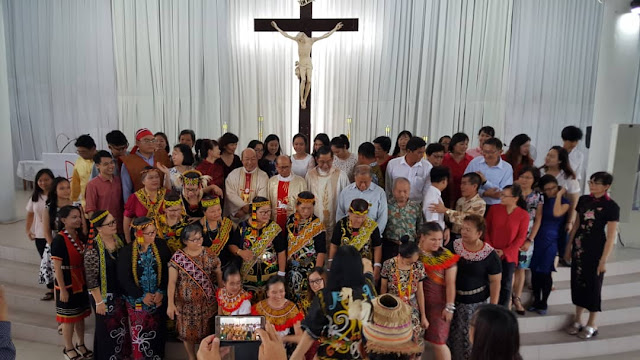Monsignor Francis Kuleh Usat
Year of birth: 1950
Year of Ordination: (1978)
Empalah, Philip
Year of birth: 1952
Year of Ordination: (1978)
facebook - https://www.facebook.com/philipempalah.keling
1976 - Graduated from St. Peter's College (New Jersey)
1970 - Graduated from SMK Bintulu
Mering, Peter
Year of birth: 1951
Year of Ordination: (1978)
Monsignor (Msgr) Francis Kuleh Usat was from Long Banyok, Baram and Rev Fr Peter Mering was from Uma Akeh. Both of them were ordained priests on 19th Nov 1978 at Long Banyok, Baram. In the same year Rev Fr Philip Empalah was ordianed Priest on the 10th of September at St George's Church Sebauh. Monignor Francis Kuleh and Rev Fr Peter Mering were the first Kenyah priests in Sarawak. Rev Fr Philip Empala was also the first Iban Priest to be ordianed in the diocease.
Msgnr Kuleh is the first Kenyah to become Monsignor. The title of Monsignor in the Roman Catholic Church signifies a priest who has distinguished himslef and has been honored by the pope for his service to the Church.
Bishop Rev Richard Ng and priests from all parishes in the Miri Diocese concelebrated the Mass.
Among those present were three missionary sisters (Mensa Domini Sisters) from the Philippines who were attached to the Miri Diocese as well as family members of the three priests, Assistant Minister of Tourism, Arts and Culture Datuk Lee Kim Shin and wife Datin Christina Kong Shui Lin, Piasau assemblyman Datuk Sebastian Ting,
Miri Diocese covers 53 per cent of Sarawak – stretching an area from Belaga District to Bintulu, Miri, Limbang and Lawas divisions with a population of over 97,000 Catholics. Miri alone has more than 12,000 catholics.
The old Miri church was demolished to make a new cathedral in 1972. On May 31, 1976, Pope Paul VI establieshed a new church province in East Malaysia and Miri vicariate was raised to the level of a diocese.
On May 20, 1977, Pope Paul VI appointed Father Anthony Lee as the first bishop of the Diocese of Miri. Six months later he was ordained in St Joseph's Cathedral on November 20th and the Diocese of Miri was officially proclaimed on the same day.
The three priests have dedicated themselves to the service of the varies tribes in their Parish. The first Catholic mission was actually in Marudi, a settlement on the Baram river, further inland from Miri. With the discovery of oil on the coast, everything was moved from Marudi to Miri in 1912. Father Henry Jansen, a Mill Hill missionary was the very first to set foot into the Baram in 1930s'. He started the first catholic mission in Marudi, then Kampung Kuala Tutoh and then to Long Banyok ( Fr Francis Kuleh longhouse) before making his way upriver to long San and Lio Mato in the upper reaches of the Baram river. He went by foot up the mountains to reach the furtherst Kenyah and Kayan community. This challenging task of spreading the good news to the Kenyah and Kayan commnnity was now being continued on by the three priests for 40 years!
The Sacerdotal Ruby Celebration (40th anniversary) Mass started at 4pm in the afternoon and was followed by dinner at one of the golf clubs. Upon arrival the three Jubilarians accompanied by Bishop Richard Ng and the other dignitaries and priests were given a traditional welcome.
The Kenyah traditional attire worn by both male and female are woven with multicolored beads and adorned with the contrast looks usually on a black cloth.
Sleek and beautiful, custom clothing for women is called a Ta and Sepei Sapaq for male.
Ta includes a headgear usually worn by the elderly. Women wearing a Ta is normally complete with decorative bead necklace and beautifully decorated with sequins.Ta includes a headgear usually worn by the elderly.
The sedangakan Sepai Sapaq worn by the men is generally very similar to that of the women with colorful motif designs. The elders would wear the Sapag Sepei as a vest (jacket) as the one worn by Monsignor Francis kulleh. Subordinates wear a loincloth called Abet Kabog. Usually the men complement sapaq sapei girded with a saber.
The motif designs on the clothing normally replicate pictures of animals and plants such as tigers and hornbills. If the pictures are of hornbill or a tiger means it is for gentle wear. If the designs are of plants then it is for the ordinary people.
These traditional custom clothing are worn only when celebrating a big event or welcoming distinguish guest.
There were also cultural performances conducted by the various ethnic groups – Kayan and Kenyah dancers, the Melanau and Iban. They then jointly cut their 40th anniversary cake and were each given a present with Papal blessing and gifts.
In his homily, his lordship Rt Rev Bishop Richard Ng congratulated the three Jubilarians, commended them for their unselfish dedication in carrying out their priestly duties despite the many challenges.
“Like all life’s journey, the journey of a priest is not easy. I am sure our three Jubilarians have their fair share of joys and disappointments, of faithfulness and failures, of being filled with God’s presence and his absence.
But in the end, what matters most is that they remain as friends of God and priests for the people of God. We thank and praise God for his choice of our three Jubilarians and for giving them the courage to say ‘Yes’. God not only chose them but also sustained and filled them with his love and mercy,” said Bishop Richard.
Photography - Dennis Ng
Story compiled by Ben Chang
Compiled by Ben Chang




















































